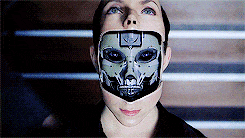2023 will see the democratization ofArtificial Intelligence.
At least, that’s what many professionals agree, given the various trends that are beginning to emerge: open source, generative AI, specific regulations on the subject…
Proof of this is that by now, almost everyone has heard of ChatGPT, and prevention and detection systems have already been put in place to prevent certain types of fraud.
The fact that Google and Microsoft have decided to launch their own conversational robots only confirms that AI has a bright future ahead of it.
Don’t believe in myths
Artificial intelligence is often perceived as a danger to humankind or to jobs because of its association with science-fiction films such as “Terminator” or “I Robot”.

But that doesn’t have to be the case.
In the digital age, where billions of pieces of data are created every day, AI should actually be seen as a suite of tools that can help solve problems faster and instantly interpret complex data once the right questions have been asked and the tool is properly configured.
An invaluable aid for workers who will simply correlate a large amount of data faster than a human being could.
An analogy could well be made with land cultivation a century ago. Back then, farmers cultivated small plots of land with the tools at their disposal, such as ploughs and spades. Later, with the advent of technology, tools were developed that enabled thousands of hectares to be cultivated with less effort.
Technological advances have come to relieve human labor, not replace it.
We need to adapt AI to our business, not the other way round
Of course, certain professions and sectors are more likely than others to adopt this technology.
Take, for example, companies that process large amounts of data on their customers and operations.AI and ERP now combine to deliver real added value, providing accurate information, proactive recommendations and much faster analysis than manual processing.
Instead of replacing workers, AI can accompany them in their work by helping them understand complex data.

Let’s take the example of a baker a step further. In principle, he will have no immediate need for AI. His expertise is irreplaceable: flours and ferments are living materials, too changeable and irregular to be mastered by artificial intelligence.
But if it ever needs to process large volumes of data on its customers or operations, then there will undoubtedly be added value to be found with AI.
It’s easy to see how cash technology will evolve to secure and facilitate the transaction, freeing up the customer’s and the saleswoman’s attention.
The central cash register can be increasingly intelligent, with a diversification of business applications: remote order management, inventory, purchasing, e-commerce site, hygiene and traceability procedures, consumer information (ingredients, allergens), sales recommendations, etc.
The user experience at the point of sale and the integration of digital tools will be at the heart of innovation, enriching the commercial relationship.
The human race still has a long way to go
It’s quite understandable that certain job categories fear for their future. But rather than panic, let’s look at this as an opportunity to learn new subjects and bring their touch of humanity that no artificial intelligence yet possesses.
In 2019, the OECD stated that, “Only 14% of existing jobs are at risk of complete automation, not nearly 50% as other research suggests.” Furthermore, 32% of jobs could “profoundly change”, without actually disappearing.
There is still a huge gap to be bridged before we can achieve AI that is comparable to human intelligence, particularly in terms of its ability to understand the context of interactions between individuals and/or with objects. That’s why integrating these new technologies with a strategic approach is essential if we are to manage our business effectively and keep pace with changes in the world of work.
AI is and will remain the result of a software architecture (type of neural networks, number of layers, learning methods, etc.) derived from human logic.
Repetitive, uncomplicated tasks should therefore be left to the machine, and the development of concepts and projects to man.
The development of AI is not destined to work against human beings, as there will always be a need for human beings to ask the right questions and bring the work of these intelligences to fruition.
So it’s important to understand its added value now, and use it strategically to support employees’ work and help them evolve rather than replace them.
This article by Davy Tessier, CEO and founder of Furious, can be found in Forbes.